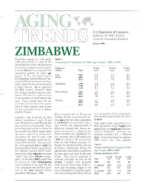
An official website of the United States government
Here’s how you know
Official websites use .gov
A .gov website belongs to an official government organization in the United States.
Secure .gov websites use HTTPS
A lock (
) or https:// means you’ve safely connected to the .gov website. Share sensitive information only on official, secure websites.
-
//
- Census.gov /
- Publications /
- Aging Trends: Zimbabwe
Aging Trends: Zimbabwe
Aging Trends: Zimbabwe
Introduction
Population aging is a well publicized phenomenon in most of the industrialized world, with attention focused on a range of socioeconomic issues have accompanied the numerical growth of older groups. In less developed regions still grappling with problems of primary health and economic development, aging has not yet emerged as a major concern. As we approach the 21st century, however, many developing countries such as Zimbabwe will witness a rapid increase in the number of their elderly citizens. These nations have the opportunity to learn from the experience of other nations, and to plan for the inevitable strains of graphic change.
Currently, only 6 percent of Zimbabwe's population is aged 55 and over; 2.8 percent is over 65; and less than 1 percent is 75 and older. These percentages are similar to those for the overall East Africa region (table 1) and are expected to remain static throughout the next 15 years, with subsequent increases projected between 2005 and 2020. As in any society, such aggregate mask the heterogeneity of elderly populations. For example, present elderly members of the white are much "older" than their counter parts. In the early 1980's, more than 13 percent of white Zimbabweans were estimated to be aged 60 and over, compared with less than 3 percent of the total national African population (Hampson, 1985).
Share
Related Information
Some content on this site is available in several different electronic formats. Some of the files may require a plug-in or additional software to view.
 Yes
Yes
 No
NoComments or suggestions?


Top

